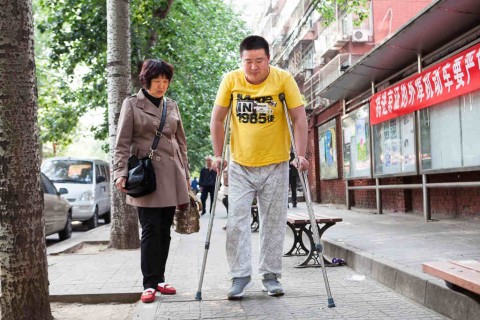Problemas de movimiento y coordinación
La EM puede causar problemas con el movimiento, el equilibrio y la coordinación
Last updated: 27th October 2021

After years in a wheelchair Little Gao is able to walk a few steps with crutches. It is good for him to flex the muscles in his legs and aids his physical recovery. Reproduced with the kind permission of Li YouHao,© 2014 Li
La EM puede causar problemas con el movimiento, el equilibrio y la coordinación, como por ejemplo:
- pérdida de equilibrio
- temblores
- inestabilidad al caminar (ataxia)
- mareos (vértigo)
- torpeza de una extremidad
- falta de coordinación
- debilidad muscular
- tirantez, rigidez o «tirón» de los músculos (espasticidad)
- espasmos musculares involuntarios
Estos problemas suelen ser los responsables de la discapacidad física que puede acumularse en la EM con el paso del tiempo.
Se cree que los problemas de movimiento están causados por daños en la mielina del cerebelo y sus conexiones, lo que perjudica el funcionamiento de la red y provoca movimientos descoordinados. Se ha descubierto que la pérdida de equilibrio y el vértigo se deben a lesiones en las complejas vías que coordinan la información visual, espacial y de otro tipo que llega al cerebro y que es necesaria para producir y mantener el equilibrio corporal.
¿Se pueden tratar o controlar estos síntomas?
Con frecuencia, estos síntomas se pueden aliviar mediante la fisioterapia y, en muchos casos, las intervenciones iniciales, como los estiramientos, el ejercicio y la rehabilitación resultan útiles.
Se han utilizado varios medicamentos para tratar la espasticidad, como el baclofeno, la tizanidina, el diazepam y el dantroleno, aunque estos tienen efectos secundarios que pueden impedir que algunas personas los toleren.
Solo hay unos pocos tratamientos farmacológicos que han demostrado ayudar a la ataxia o a los temblores y existen algunas opciones quirúrgicas para estos síntomas concretos.
Por lo general, los problemas de equilibrio y el vértigo se tratan con medicamentos para el mareo.
Madrid, Spain, 10/2011. Heads turn at the zoo’s amphitheatre as David carries his wife, Almudena, up to her seat. On the platform below, her wheelchair is equally eye-catching among a small horde of baby strollers. Making sure their son has an active life is more important than giving any serious consideration to how strangers react to the ways they cope with living with MS. Credit: Lurdes R. Basolí. Published with kind permission of the European Multiple Sclerosis Platform.
San Quirico D'Orcia, Italy, 02/2012. Martina Vagini has balance problems; in addition to using canes, she takes the trouble to go to the side of a wide staircase to be close to the railing. In a country like Italy, disability and history create a difficult barrier: laws that encourage (or even mandate) public buildings to improve accessibility often collide with laws that protect artistic heritage. Italy ranks fifth in the world as a tourist destination: in difficult economic times, beauty for the visitor often trumps access for the locals. Credit: Carlos Spottorno. Published on this website by kind permission of the European Multiple Sclerosis Platform.